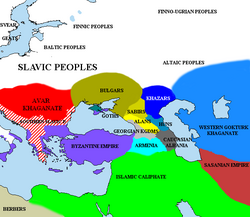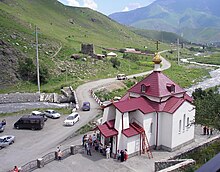Alans
[10] In 428 CE, the Vandals and Alans crossed the Strait of Gibraltar into North Africa, where they founded a kingdom which lasted until its conquest by forces of the Byzantine Emperor Justinian I in 534.
[21][22] The ethnonym Alān is a dialectal variant of the Old Iranian *Aryāna, itself derived from the root arya-, meaning 'Aryan', the common self-designation of Indo-Iranian peoples.
[22] Like the name of Iran (*Aryānām), the adjective *aryāna is related to Airyanəm Waēǰō ('stretch of the Aryas'), the mythical homeland of the early Iranians mentioned in the Avesta.
[26] The Alans were also known over the course of their history by another group of related names including the variations Asi, As, and Os (Romanian Iasi or Olani, Bulgarian Uzi, Hungarian Jász, Russian Jasy, Georgian Osi).
Related to the Asii who had invaded Bactria in the 2nd century BCE, the Alans were pushed west by the Kangju people (known to Graeco-Roman authors as the Ἰαξάρται Iaxártai in Greek, and the Iaxartae in Latin), the latter of whom were living in the Syr Darya basin, from where they expanded their rule from Fergana to the Aral Sea region.
[30] In the 1st century CE, the Alans migrated westwards from Central Asia, achieving a dominant position among the Sarmatians living between the Don River and the Caspian Sea.
7.4) how Alans (whom he calls a "Scythian" tribe) living near the Sea of Azov crossed the Iron Gates for plunder (72 CE) and defeated the armies of Pacorus, king of Media, and Tiridates, King of Armenia, two brothers of Vologeses I (for whom the above-mentioned inscription was made): Now there was a nation of the Alans, which we have formerly mentioned somewhere as being Scythians, and living around Tanais and Lake Maeotis.
This king gave them leave to come through them; so they came in great multitudes, and fell upon the Medes unexpectedly, and plundered their country, which they found full of people, and replenished with abundance of cattle, while nobody dared make any resistance against them; for Pacorus, the king of the country, had fled away for fear into places where they could not easily come at him, and had yielded up everything he had to them, and had only saved his wife and his concubines from them, and that with difficulty also, after they had been made captives, by giving a hundred talents for their ransom.
Now, Tiridates was king of that country, who met them and fought them but was lucky not to have been taken alive in the battle; for a certain man threw a noose over him and would soon have drawn him in, had he not immediately cut the cord with his sword and escaped.
[4] These lands had earlier been occupied by the Aorsi and the Siraces, whom the Alans apparently absorbed, dispersed and/or destroyed, since they were no longer mentioned in contemporaneous accounts.
[4] They were eventually driven back by Arrian, the governor of Cappadocia, who wrote a detailed report (Ektaxis kata Alanoon or 'War Against the Alans') that is a major source for studying Roman military tactics.
[7] The Later Han dynasty Chinese chronicle, the Hou Hanshu, 88 (covering the period 25–220 and completed in the 5th century), mentioned a report that the Yancai nation (奄蔡 lit "Vast Steppes" or "Extensive Grasslands" < LHC *ʔɨamB-sɑC; a.k.a.
Hesu (闔蘇), compare Latin Abzoae,[35][36] identified with the Aorsi (Ancient Greek Αορσιοι)[37][38]) had become a vassal state of the Kangju and was now known as Alan (< LHC: *ʔɑ-lɑn 阿蘭)[39][40][a] Y.
99 and 220, does, referring for additional support to HSPC 70.6b where the name Ho-su 闔蘇, reconstructed in ‘Old Chinese’ as ĥa̱p-sa̱ĥ, can be compared with Abzoae found in Pliny VI, 38 (see also Pulleyblank (1968), p. 252).
Gregory of Tours mentions in his Liber historiae Francorum ("Book of Frankish History") that the Alan king Respendial saved the day for the Vandals in an armed encounter with the Franks at the crossing of the Rhine on 31 December 406).
According to Gregory, another group of Alans, led by Goar, crossed the Rhine at the same time, but immediately joined the Romans and settled in Gaul.
[48][49] In 442, after it became clear to Aetius that he could no longer rely upon the Huns for support, he turned to Goar and persuaded him to move some of his people to settlements in the Orleanais in order to control the bacaudae of Armorica and to keep the Visigoths from expanding their territories northward across the Loire.
Goar settled a substantial number of his followers in the Orleanais and the area to the north and personally moved his own capital to the city of Orleans.
Under Goar's successor Sangiban, the Alans of Orléans played a critical role in repelling the invasion of Attila the Hun at the Battle of Châlons.
However, the Alans, who were Chalcedonian Christians like Clovis, desired cordial relations with him to counterbalance the hostile Arian Visigoths who coveted the land north of the Loire.
[52] Following the fortunes of the Vandals and Suebi into the Iberian peninsula (Hispania, comprising modern Portugal and Spain) in 409,[53] the Alans led by Respendial settled in the provinces of Lusitania and Carthaginensis.
[citation needed] The Alans who remained in their original area of settlement north of the Caucasus (and for a time east of the Caspian Sea as well), came into contact and conflict with the Bulgars, the Gökturks, and the Khazars, who drove most of them from the plains and into the mountains.
They participated in Mongol invasions of Europe and the Song dynasty in Southern China, and the Battle of Kulikovo under Mamai of the Golden Horde.
John of Montecorvino, archbishop of Dadu (Khanbaliq), reportedly converted many Alans to Roman Catholic Christianity in addition to Armenians in China.
We believe they have been besieging it for twelve years and they (the Alans) put up courageous resistance and killed many Tatars, including many noble ones.This twelve-year-long siege is not found in any other report, however the Russian historian A. I. Krasnov connected this battle with two Chechen folktales he recorded in 1967 that spoke of an old hunter named Idig who with his companions defended the Dakuoh mountain for 12 years against Tatar-Mongols.
[71] Mangu enlisted in his bodyguard half the troops of the Alan prince, Arslan, whose younger son Nicholas took a part in the expedition of the Mongols against Karajang (Yunnan).
[77][not specific enough to verify] It is supposed that the Iasi, a group of Alans founded a town in the northeast of Romania (about 1200–1300), near the Prut river, called Iași.
The fourth-century Roman historian Ammianus Marcellinus wrote this on the appearance of the Alans: Nearly all the Alani are men of great stature and beauty; their hair is somewhat yellow, their eyes are terribly fierce.
The fact that many of the samples share the same y- and mtDNA raises the possibility that the tested individuals belonged to the same tribe or even were close relatives.
In the 13th century, invading Mongol hordes pushed the eastern Alans further south into the Caucasus, where they mixed with native Caucasian groups and successively formed three territorial entities each with different developments.









